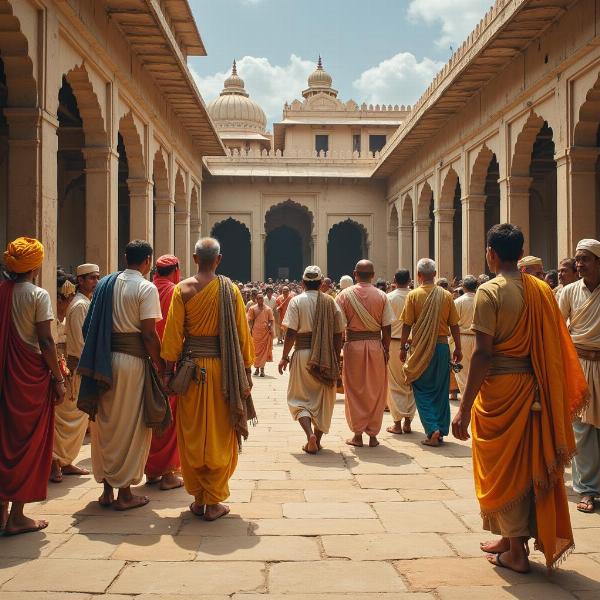Understanding the Hindi phrase for “ancient times” opens a window into India’s rich cultural heritage. It’s more than just a translation; it’s a connection to a past filled with mythology, empires, and philosophical advancements. Knowing how to express “ancient times” in Hindi allows you to engage more deeply with historical texts, conversations, and the overall cultural landscape of India. This article will explore various ways to say “ancient times” in Hindi, delving into their nuances and providing context for their usage.
Exploring the Hindi Translations for “Ancient Times”
Several Hindi words and phrases beautifully capture the essence of “ancient times.” Each carries its own subtle connotations, offering a nuanced understanding of the past. Here are some of the most common translations:
- प्राचीन काल (Prachin Kaal): This is perhaps the most direct and widely used translation. “Prachin” means ancient, and “Kaal” means time or period. Together, they form a straightforward expression for “ancient times.”
- पुरातन काल (Puratan Kaal): “Puratan” also means ancient, giving this phrase a similar meaning to “Prachin Kaal.” However, “Puratan” sometimes implies a sense of antiquity that is even further back in time, suggesting something very old and venerable.
- अतीत काल (Atit Kaal): “Atit” refers to the past, and “Kaal,” as we know, means time. This phrase emphasizes the past in a general sense, encompassing both the recent and distant past. While it can be used to refer to ancient times, it’s broader in scope.
- प्राचीन युग (Prachin Yug): “Yug” signifies an era or age. This term evokes a sense of a distinct historical period, making it suitable for referencing specific ancient eras like the Vedic age or the Mauryan empire.
 Depiction of Prachin Kaal
Depiction of Prachin Kaal
Understanding the Nuances of Each Phrase
While these phrases share the common theme of referring to the past, understanding their subtle differences is crucial for accurate and effective communication. For instance, if you’re discussing the Indus Valley Civilization, “Prachin Kaal” or “Puratan Kaal” would be appropriate choices. However, if you’re talking about a historical event that happened a few centuries ago, “Atit Kaal” might be a more fitting term.
Delving Deeper into Ancient Indian History
Knowing how to say “ancient times” in Hindi is just the first step. India’s ancient history is incredibly vast and diverse, spanning millennia and encompassing a multitude of kingdoms, religions, and philosophical schools of thought. From the Indus Valley Civilization to the Mughal Empire, each period offers a unique glimpse into the evolution of Indian society.
The Significance of Ancient Texts
Ancient Indian literature, such as the Vedas, Upanishads, and epics like the Ramayana and Mahabharata, provides valuable insights into the beliefs, customs, and social structures of ancient times. These texts are not just historical documents; they continue to shape Indian culture and thought to this day.
How to Use “Ancient Times” in Conversation
Imagine you’re discussing the architectural marvels of ancient India with a Hindi speaker. You could say, “प्राचीन काल की वास्तुकला अद्भुत थी” (Prachin Kaal ki vastukala adbhut thi), which translates to “The architecture of ancient times was amazing.” Alternatively, you could use “Puratan Kaal” or “Prachin Yug” depending on the specific historical period you’re referencing.
Conclusion: Embracing the Richness of Ancient India
Understanding the various ways to express “ancient times” in Hindi is more than just a linguistic exercise; it’s a gateway to appreciating the depth and complexity of Indian history and culture. By learning these phrases and exploring the historical context behind them, you can engage more meaningfully with India’s rich heritage.
FAQs:
- What is the most common way to say “ancient times” in Hindi? The most common translation is प्राचीन काल (Prachin Kaal).
- What is the difference between “Prachin Kaal” and “Puratan Kaal”? While both mean “ancient times,” “Puratan Kaal” sometimes implies a greater sense of antiquity.
- Can “Atit Kaal” be used to refer to ancient times? Yes, but it’s a broader term that encompasses both the recent and distant past.
- What does “Yug” mean in Hindi? “Yug” signifies an era or age.
- Why is it important to understand the nuances of these phrases? Understanding the nuances allows for more accurate and effective communication.
Meaning-Hindi.in is your trusted partner for all your Hindi translation needs. We offer a wide range of professional translation services, from business and legal documents to technical manuals and website localization. Our expert team ensures accurate and culturally sensitive translations, helping you bridge the language gap effectively. Contact us today at [email protected] or call us at +91 11-4502-7584 to discuss your translation requirements. Meaning-Hindi.in is committed to delivering high-quality translations that meet your specific needs.